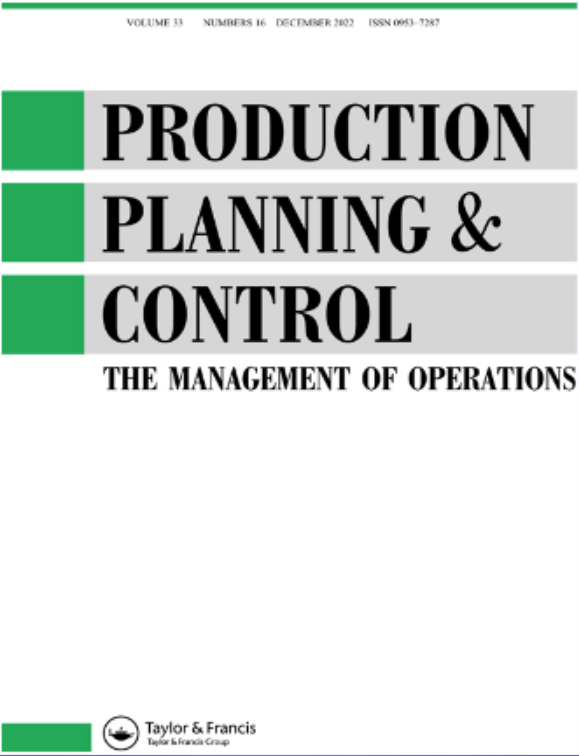在运营管理中激活减少设置的活动
IF 5.4
3区 管理学
Q1 ENGINEERING, INDUSTRIAL
引用次数: 7
摘要
本研究项目从当前行业面临的困难和持续过程改进文献中的知识缺口出发,对减少设置方法的现状提出了挑战。本研究的目的是研究如何将SMED(单分钟换模)与预置系统(预测工具或设备调整)结合起来,以提高生产系统在实践中的生产率。首先,通过文献综述,扩大对中小企业相关方法的理解,以及目前相关文献的知识缺口。接下来,提出了一种将SMED与预置系统相结合的新方法,并在与行业密切合作的纵向研究中进行了实证验证。在干预之前、期间和之后进行的定性和定量观察证明了所测试方法的充分性能。所获得的主要成果包括:(i)安装时间减少87%,贴标机的整体设备效率(OEE)提高33.8%,(ii)整条生产线的OEE提高17%,(iii)批量减少约45%,(iv)每月48.533个零件的生产率系统性提高,这些零件占公司收入的90.5%。总体而言,本研究提出了理论完善,并通过扩展和振兴当前关于减少设置方法和过程改进的文献,为精益生产实施的研究和实践做出了贡献。本研究提供的精细化方法和规定性指导方针,使工业从业者能够在实践中提高生产系统的性能。本文有助于扩大企业对生产/运营管理研究成果的最佳实践的吸收。本文章由计算机程序翻译,如有差异,请以英文原文为准。
Revitalising the setup reduction activities in Operations Management
Abstract This research project challenges the status quo regarding setup reduction methods from the current difficulties faced by industries and the knowledge gaps in the literature on continuous process improvement. The purpose of this study is to examine how it is possible to combine SMED (Single-Minute Exchange of Die) with Presetting systems (anticipation of tools or devices adjustments) to improve production systems’ productivity in practice. First, a literature review was performed to expand the understanding of SMED-related methods and the current knowledge gaps in the relevant literature. Next, a revitalised method combining SMED with Presetting systems was proposed and empirically validated in close collaboration with the industry in a longitudinal study. Qualitative and quantitative observations made before, during and after the intervention demonstrated the adequate performance of the tested method. The main results obtained include (i) 87% reduction in the setup time and a 33.8% increase in the Overall Equipment Effectiveness (OEE) of the labelling machine, (ii) 17% increase in the entire line’s OEE, (iii) about 45% reduction of the lot sizes, (iv) a systemic improvement in productivity of 48.533 parts per month into production line responsible for 90.5% of the company’s revenues. Overall, this study proposed theory refinements and contributes to research and practice on Lean Production implementation by expanding and revitalising the current literature on setup reduction methods and process improvements. The refined method and the prescriptive guidelines provided in this study enable industrial practitioners to increase production systems’ performance in practice. The paper contributes to expanding the absorption of best practices in Production/Operations Management research results in firms.
求助全文
通过发布文献求助,成功后即可免费获取论文全文。
去求助
来源期刊

Production Planning & Control
管理科学-工程:工业
CiteScore
19.30
自引率
9.60%
发文量
72
审稿时长
6-12 weeks
期刊介绍:
Production Planning & Control is an international journal that focuses on research papers concerning operations management across industries. It emphasizes research originating from industrial needs that can provide guidance to managers and future researchers. Papers accepted by "Production Planning & Control" should address emerging industrial needs, clearly outlining the nature of the industrial problem. Any suitable research methods may be employed, and each paper should justify the method used. Case studies illustrating international significance are encouraged. Authors are encouraged to relate their work to existing knowledge in the field, particularly regarding its implications for management practice and future research agendas.
 求助内容:
求助内容: 应助结果提醒方式:
应助结果提醒方式:


